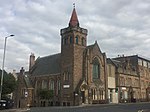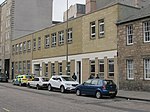Murder of Lord Darnley
1567 in Scotland16th-century murderEngvarB from February 2014History of EdinburghMary, Queen of Scots ... and 2 more
Murder in EdinburghPolitical scandals in Scotland

The murder of Lord Darnley, second husband of Mary, Queen of Scots, took place on 10 February 1567 in Edinburgh, Scotland. Darnley's lodgings were destroyed by gunpowder; his body and that of his servant were found nearby, apparently having been strangled rather than killed in the explosion. Suspicion was placed upon Queen Mary and the Earl of Bothwell, whom Mary went on to marry three months after Darnley's murder. Bothwell was indicted for treason and acquitted, but six of his servants and acquaintances were subsequently arrested, tried, and executed for the crime.
Excerpt from the Wikipedia article Murder of Lord Darnley (License: CC BY-SA 3.0, Authors, Images).Murder of Lord Darnley
Brown Street, City of Edinburgh Southside
Geographical coordinates (GPS) Address Website Nearby Places Show on map
Geographical coordinates (GPS)
| Latitude | Longitude |
|---|---|
| N 55.9456 ° | E -3.1811 ° |
Address
Greyfriars Charteris Centre
Brown Street
EH8 9RR City of Edinburgh, Southside
Scotland, United Kingdom
Open on Google Maps









